The BP Deepwater Horizon drilling rig failed on Tuesday evening April 20, 2010, 14 days ago.
This is what it looked like Saturday, May 1st. I took a satellite picture from the NRL Monterey of the Gulf of Mexico that was showing biological substances, cropped it, and color enhanced it by playing with the settings on iphoto, to make the colors have more contrast. Since oil is based on organics, this made it show up better, and I could recreate, roughly, what the LSU ESL was doing to get the oil to show up on their pictures I posted previously. Because there were thunderstorms this past weekend, the area was obscured by cloud cover often. I also noticed the government was not putting up daily picture updates.
May 1, 2010 BP Deepwater Horizon’s oil slick in the Gulf of Mexico, photo NRL Monterey, color enhanced by ARC The thicker part of the slick is the part that looks like a bird’s beak pointing upside down off the New Orleans Louisiana Delta, which is to the left in green and pink. Pink is the coastline, drawn in. The greenish tint is where the slick is thinner. The blue is the water.
*
*
This is the same picture from May 1st, larger area, without my increasing the color contrast.
May 1, 2010, BP Deepwater Horizon’s Oil slick in the Gulf of Mexico, photo NRL Monterey. The heavier part of the slick is gray, the lighter part of the slick is very hard to see, but is there and greenish grey. The coast outline is drawn in pink by the website. The ^ triangle to the north in the shoreline is the Bay of Mobile, Alabama. To find the origin of the slick, look down from the left side of that triangle of the Mobile Bay and come out from the Delta about at a 45º degree angle, where the lines would meet, is roughly where the broken drill rig is. Where the up and down brilliant blue longitude line is to the right touches shore, is where Pensicola Bay is in the Florida panhandle.
*
*
As you can see from this larger view, the slick actually has spread quite a bit towards the Florida Panhandle by Saturday the 1st.
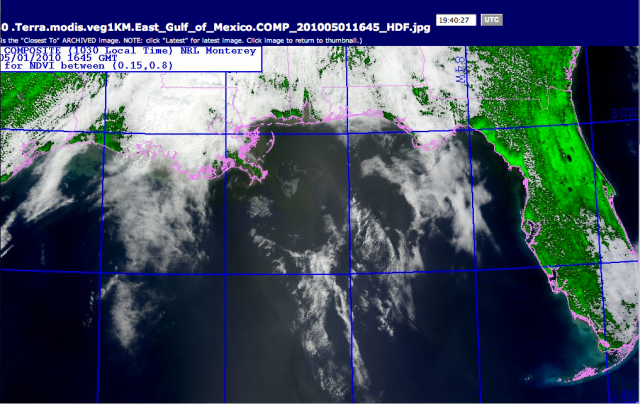
5/1/2010, Larger view of Gulf with BP DH Oil slick southwest of the New Orleans delta, spreading towards Alabama and Florida.
*
*
Sunday May 2- This lovely overlay picture below is the satellite of the eastern half of the US, including the gulf of Mexico, with the wind direction and speed marked on it. Think of the little color icons as brooms with the stick end pointing towards what way the wind is going, and the bigger the broom, the faster. There were several thunderstorm fronts moving thru to the southeast, and the wind in the Gulf is spinning in a clockwise manner, driving the waves and the oil around and around and easterly at the same time.
This is known as the “Conveyer Belt.” photo NRL Monterey

Wind Direction on Sunday the 2nd, showing the Gulf’s classic “Conveyor Belt.”
The other thing you can see here is a big low pressure system spinning off the eastern coast and it’s spinning counterclockwise. Look at Florida. Now look at Cuba, the long island under it, then to its right, the island with Haiti and the Dominican Republic, and to the right of that, little bitty Puerto Rico, the rectangle island.
Do you see how small Puerto Rico is ? Do you see how big the oil slick is, in the first picture ? Do you know how stupid White House Correspondent Cokie Roberts looked, prattling about how the oil slick is so big it was as big as Puerto Rico, all day Saturday, when she wasn’t blathering about the White House Correspondent’s dinner ?
I heard somebody well known tonight on television refer to it as being as big as Delaware. Pathetic.
It’s somewhere between South Carolina and Georgia, and it might be TEXAS sized by the time it’s done.
*
*
This is the Jet Stream wind (higher altitude) over the Gulf on Saturday. Where the Jet Stream goes, the storms and fronts track along.
5/2/2010 Gulf Jet Stream, showing typical summer pattern. Note the clockwise spin over the Gulf and the east coast, The Conveyor Belt, which will drive the water along the shores and then out past the Florida Keys and up the Eastern Seaboard, where it then will turn around somewhere in the mid Atlantic states and come back south again. photo, NRL Monterey
We Are So Screwed.
_____
This is what the Gulf and oil slick looked like Sunday, May 2nd. There have been numerous thunderstorm fronts running across and chopping up the Gulf, and the rough wave action is breaking up the slick and spreading it out, but the sharp westerly winds have been driving it east, so far keeping most of it away from the shorelines. As you can see, the slick is spreading very far south and east. If it is driven north now, when the wind shifts as it will, soon, it is going to tar up the Florida panhandle.
5/2/2010 Sunday, the 12 day, BP Oil spill, spreading out, color enhanced for contrast, purple lavender. White is cloud cover, pink is shoreline drawn in. photo NRL Monterey, color by ARC
*
*
And this is what the original looked like, 5/2, before I augmented the softer grey brown color of the oil slick.
I could not find a decent image for Monday, May 3rd. (above photos are taken from the archives of NRL Monterey CA Marine Meteorology Public Division Laboratory, public releases, NexSat, and come with a disclaimer that they are not endorsed officially by the NRL. permanent bookmark for the page http://www.nrlmry.navy.mil/TC…. , section East Pacific and West Coast. )
___
Monday’s Oil Slick News had 2 interesting developments.
First, the Governor of CA, Arnold Schwarzenegger, announced at a press conference that he was withdrawing his endorsement of drilling more oil wells offshore in Federal waters, down off the shore of Santa Barbara in Ventura County.
This was a huge deal, because Schwarzenegger, a Republican who is loathed by the Flat Earth Anthropogenic Republicans who believe Rocks Just Turn Into More Oil and The Sun is Getting Hotter or the Earth is Getting Bigger, had agreed to let drilling be done in the Tranquillion Ridge in exchange for the very broke state getting some of the revenues. http://news.firedoglake.com/20…
Schwarzenegger is also under fire because the Flat Earth contingent is trying to overturn our Greenhouse Gasses law.
“You turn on the television and see this enormous disaster, you say to yourself, ‘Why would we want to take on that kind of risk?'” he said at a news conference near Sacramento.A drilling deal struck in 2008 between some environmental groups and Plains Exploration & Production Co., known as PXP, was estimated to bring the state some $100 million a year. The governor’s budget had set aside that money to keep state parks open in the next fiscal year.
San Francisco Examiner: http://www.sfexaminer.com/loca…
Although the CA coast was not part of the President’s plan to expand offshore drilling, the modern day environmental movement was started as a reaction to the horrible 1969 oil rig blowout by a Union Oil Co platform off the coast of Santa Barbara. 27 platforms still produce oil off the CA coast.
___
The other news on the 13th day was that BP Oil finally admitted that the Deepwater Horizon rig blew out because of defective equipment, specifically, a big series of cut off valves called a Blow Out Protector, or BOP, which didn’t shut off when the rig blew, and have not responded to further attempts to shut them with remote controlled submarine robots.
(British, Australian, and Malaysian news sources have been very good on this story)
The Australian.com May 4, 2010
http://www.theaustralian.com.a…
Using remote-controlled submarines to shut off the leaking oil well in the Gulf of Mexico is like doing “open heart surgery at 5000 feet in the dark”, says the head of BP’s American operations,BP America chairman and president Lamar McKay….“I believe that we’ve got a failed piece of equipment,” Mr McKay said. “We don’t know why it failed yet,” but BP’s focus was on “dealing with the source of the oil, dealing with it on the surface and dealing with it on the beach or the marsh if it occurs”.
(BP Dude, it is going to occur. But just work on shutting the damned thing off harder. )
The CEO of BP, Tony Hayward, who will be interacting with officials and lawmakers from the US Government later today, on Monday sounded more petulant about criticisms that the drilling rig and well should have been equipped with another remote shut off, called an acoustic, saying that it would not have worked because they have discovered, after trying to turn the Blow Out Preventer BOP valves off with the remote unmanned submarines, that they can’t turn them off anyway because
neither of them would have worked, because they were broken anyway.
Fortunately Mr Hayward does not design automobiles, because this is akin to saying that you don’t need the brake pedal when you can have an unmanned robot try to turn the ignition key off instead after the accelerator sticks – after the car goes through the guardrail and over the cliff.
“They [wells] are highly complex things, not just holes in the ground, and what you need for a discovery or exploration well is going to be very different from something that is going to be producing from a platform above it.”
Some ongoing discussion at The Oil Drum blog about just what goes on during preparing a well for production:
http://www.theoildrum.com/node…
This well was finished with the actual drilling and was being shut down and prepped so the drilling rig could be floated away and replaced with the production platform. There is a metal pipe that is put down the well shaft as it is being drilled, and cement is put between it and the drill shaft walls of rock or dirt, to hold it in place. This is called casing.
The well was in the final stages of being closed down…. This meant that the pipe that would ultimately carry the oil and gas to the surface, the production casing string, had been put into place. To hold that pipe in place, and to make sure that it is sealed so that no fluid can flow into the gaps between this tube and the rock walls left by the initial drilling of the hole, the casing had been cemented in place.At the time that the explosion occurred on the oil rig, it appears that they had cemented the production casing in place, and were cleaning the mud from the well, prior to putting a temporary cement cap at the top of the well. This would allow them to leave the site (abandon the well), with the well ready to be connected to the pipes that would more permanently carry the oil and gas from the well.
Halliburton, ex VP Dick Cheney’s muse and former employer, did the cementing on this well, and is currently under scrutiny.
If you scroll down to the May 3, 8:18 pm comment by Nate Higgins, he has posted a graphic and photo from Superior Energy about the way they are planning to try to capture the oil with a big, undersea funnel and pipe that Wild Well Controls are building, using leftover equipment from Katrina. The containment dome is actually a huge metal box that was a coffer dam before, and it’s just ugly enough that it might work.
There are also two more amazing comments, one links to an eyewitness account on a nearby tuna fishing boat, which heard the initial “kick” of the well, and the other is from another poster who put this account together with another one. To understand what is going on, the inside of the well pipe was being flushed out with water to remove the mud. All of these actions are very carefully monitored to keep the pressure of the liquids and mud inside the pipe at a certain balance, to keep the oil down there in the formation below the sea bed. If there is a big sudden shift of a gas bubble in the oil formation miles below, because it has been disturbed, which causes a sudden, violent surge of pressure, there can be a pause or time lapse before the equipment that is supposed to react to this can engage. (That’s my theory, anyway. Remember, this deepsea drilling is a new technology.)
Comment from Petrographer, from the Oil Drum about the Tuna Fishing Witnesses (Original blog link “Fishing Trip of a Lifetime” is here, with photographs they took http://www.mudinmyblood.net/fo… )
“It’s an eyewitness account from two guys out tuna fishing right below the Deepwater Horizon on the night of April 20th. One of the guys had worked offshore, and from the story, that experience probably saved his life, as he knew what the “kick” they were watching meant, and yelled for his buddy to get their boat away from their fishing spot by the platform ASAP, which they did.
I’ve excerpted the following verbatim, with spelling/grammar errors as is, from this account that Kheris linked to above.”
ROCKMAN; as I read through the story that these two tell, it sure sounds like the unconfirmed report you heard and which you posted around 12:30 pm today, which is that someone on the platform missed seeing the well kicking back at them until the ship reported the disconnect between the tanks full of mud vs. the amount of mud that should have been pumped, is a very plausible explanation. And, when someone up top did recognize the kick, it was too late. Methane was already venting (the eyewitness account of the decibel level is scary), and when power was cut the backup system started up but sparked, and that caused the initial explosion.
Their observations are VERY interesting, and if these two eyewitnesses are right, it was the start-up of the backup electrical power system that caused the initial explosion:
anndryii’s story:
“Around 10pm the entire center of the rig started rushing water downwards over all the pipes… I’ve never seen such an event take place. I looked at my friend who previously worked offshore, and he said that’s BOP something another and the rig took a ‘kick!’ I thought the rig was sinking and that was their way of bilging… But nope! Methane gas began BLOWING out of the West side of it and the noise of the thrust was louder than anything I’ve ever herd (except for a sonic boom I herd once, and what I’m about to tell you next) My eyes began to burn and that friend I was telling you about earlier began to SCREAM, “GO, GO, GO, GO, GOOOOO!” I positioned my compass North and put the gears in WOT! At approximately 100 yds from the rig it Exploded! Puts a new meaning to explosion.The rig continued EXPLODING. A very large crew boat was tied to the rig as it blew and the ppl began rafting to that boat as it floated away slowly. I got on the radio to try to help and they told me to stay away for safety. The rig blew a few more explosions after that and began to burn down. Some of the rig began dripping into the water and the platform tilted in and turned RED HOT.
When the gas started blowing out the side of the rig they turned off the power to prevent electrical spark which would ignite the gas, but when they shut power the generator kicked on and thats all she wrote!
This eyewitness account, if true, is extraordinary.

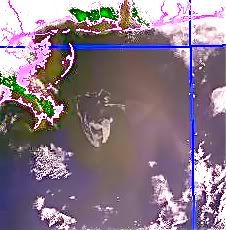
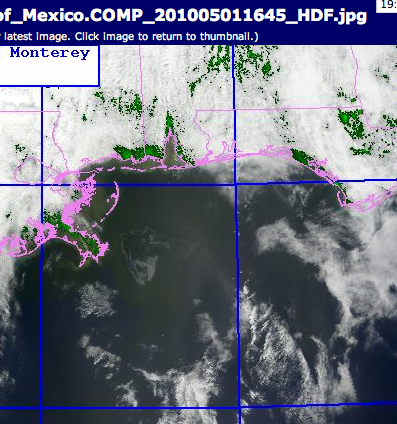
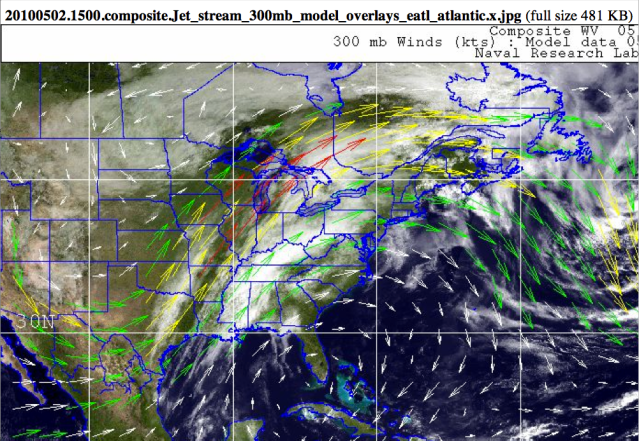

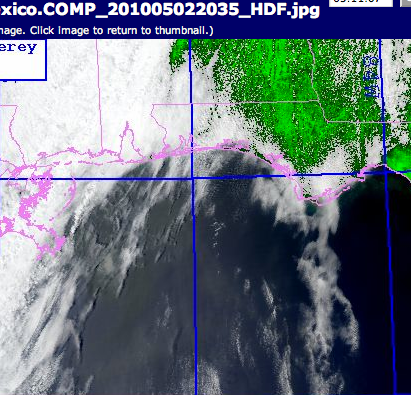
1 comments
Author
….. concept of “square miles” or “length” or “width” or “diameter” or “animated graphic of spill forecast spread for today” is having no impact upon them whatsoever.
If the account of the tuna fishing eyewitness bubbas is true, it is actually sort of funny that they went thru all that trouble to fix the boat engines and then the oil rig they are fishing next to, blows up, almost killing them. So they get to call the Coast Guard and tell them the landmark they were using to fish by….. blew up.
I might have a typo in the bookmarks above for the pictures, (groan) the site is tricky to navigate and you want the east gulf of mexico section, not the coast. Another thunderstorm just went over again. It’s not like Mother Nature is not trying to keep the oil off the beaches.
http://www.nrlmry.navy.mil/nex…
http://www.nrlmry.navy.mil/nex…